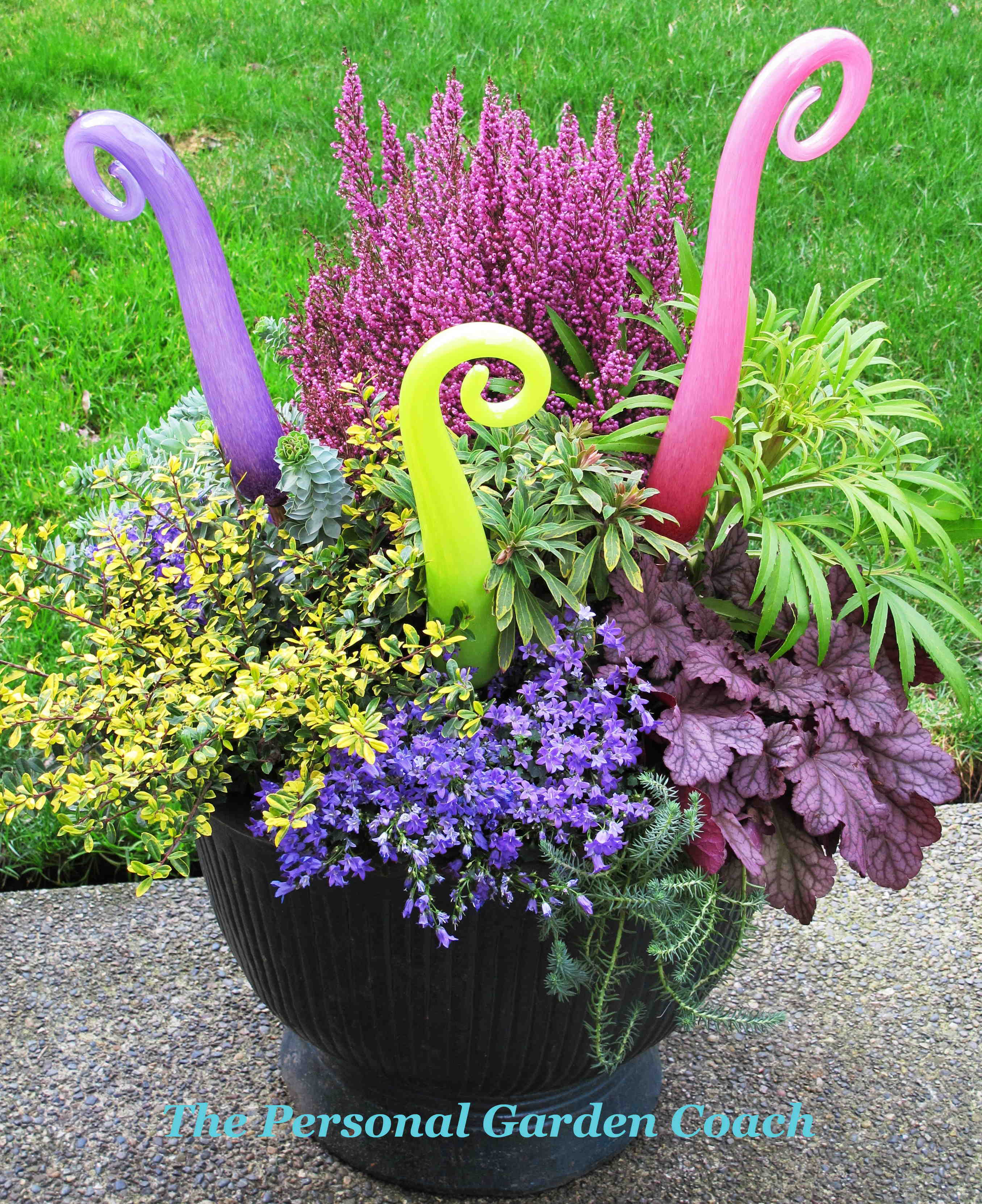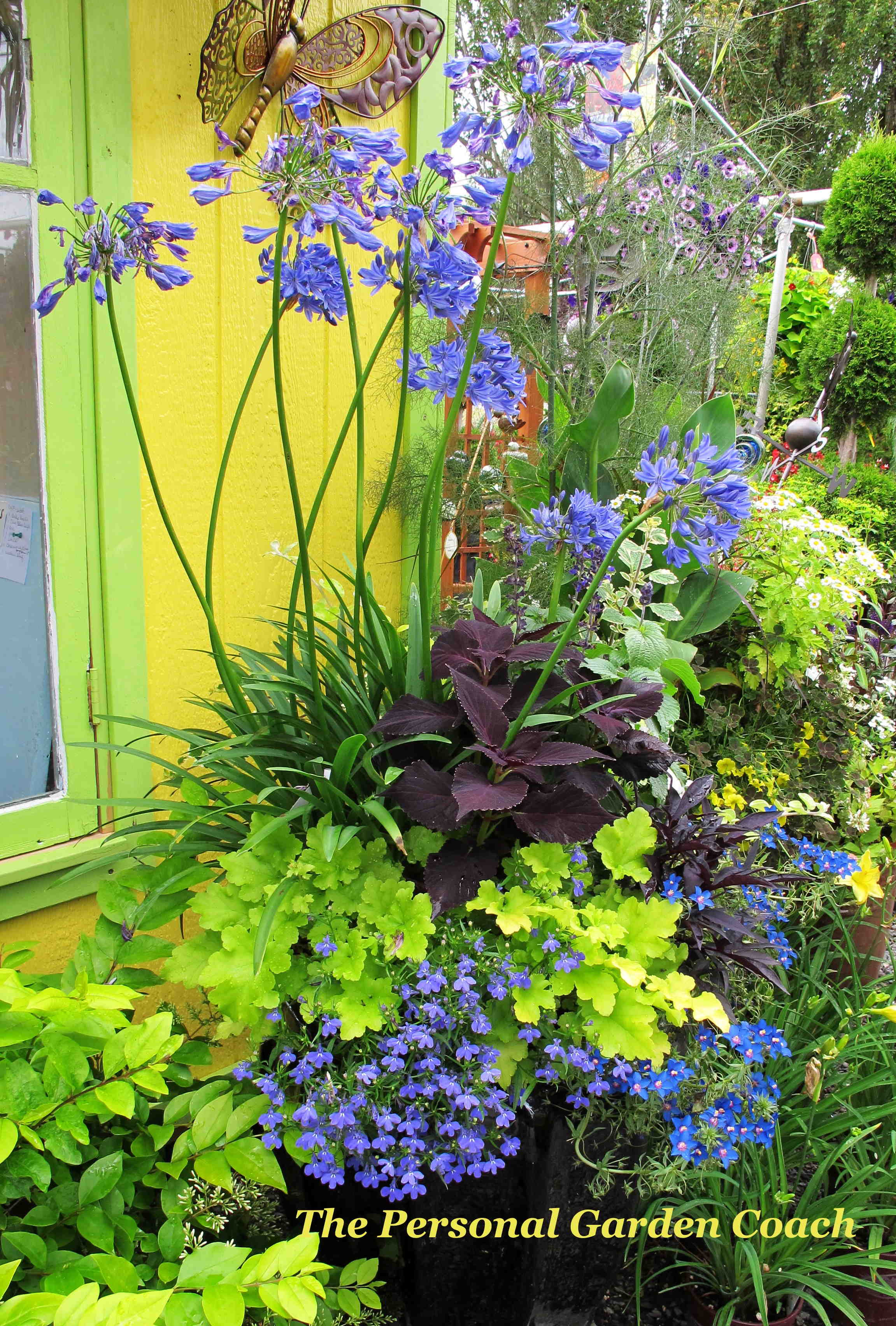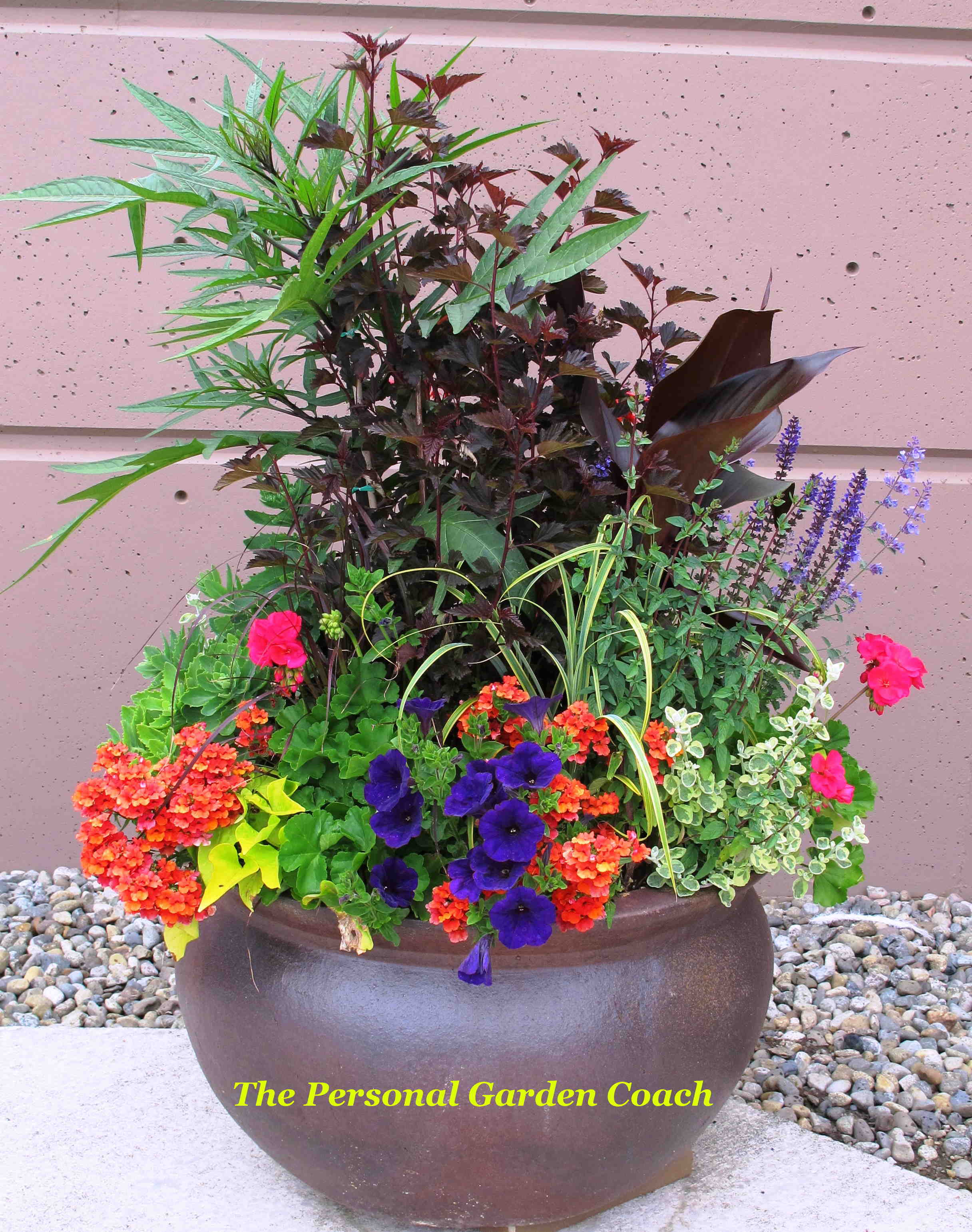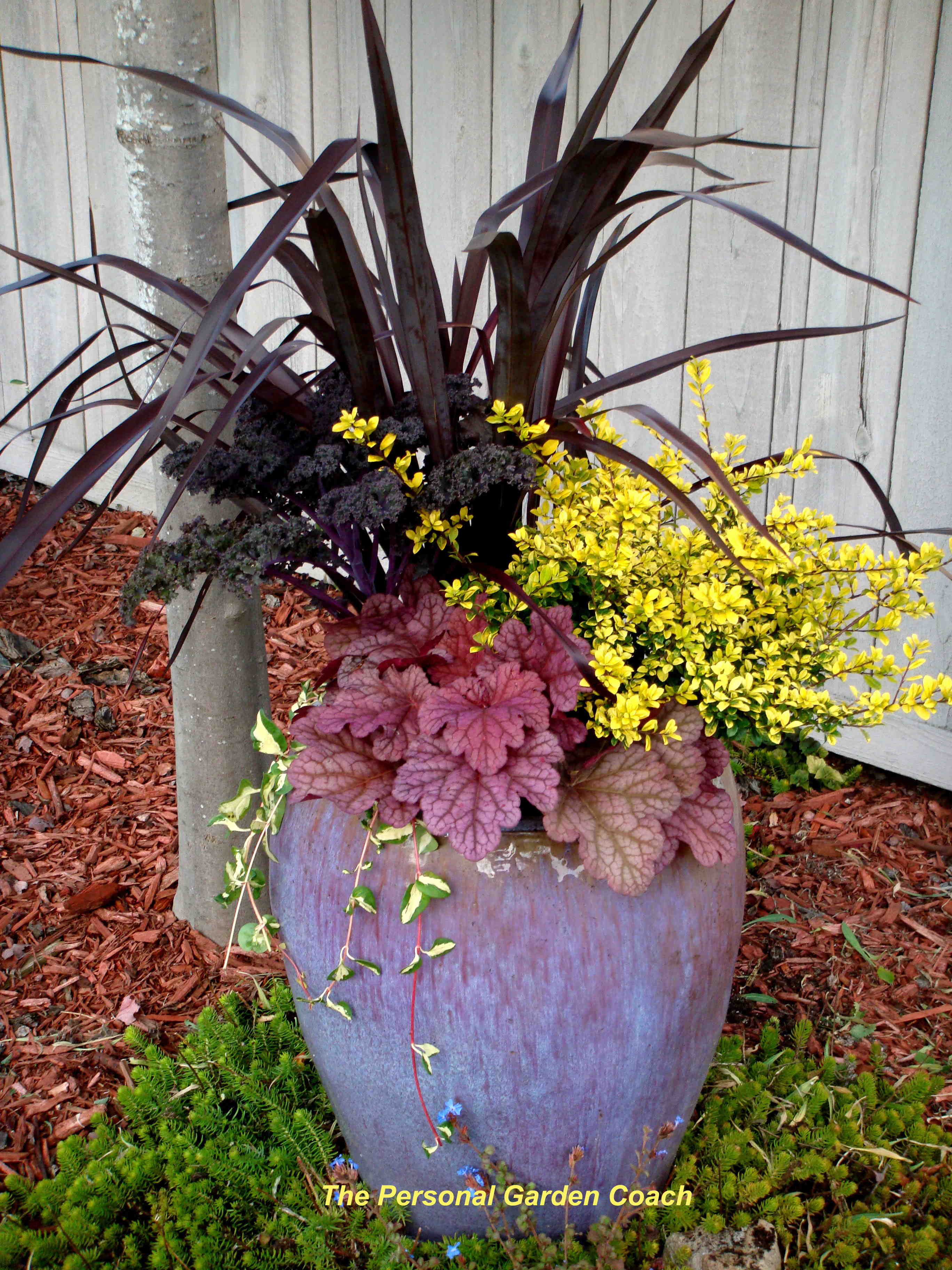Gardening in containers
Written for the Davis Enterprise, September 27 2012

A touch of whimsy? No reason garden art objects can't be part of your planter.
The flowering shrub in the back is an Erica canaliculata, a form of Scotch heather. Preferring acid soil conditions, it might not be the best choice with our alkaline water. Consider Breath-of-heaven (Coleonema) instead. The other plants include (clockwise from right): heuchera, sedum, campanula, barberry, and antoher sedum, with a euphorbia in the center. This mix would probably need some trimming and perhaps some replanting in a few months.
All photos courtesy of Christina Salwitz. Used with permission.
 Vertical contrast here is provided by common dwarf Lily-of-the-nile (Agapanthus). Gold-leaved heuchera and blue nemesias fill the perennial palate, while lobelia and burgundy coleus provide seasonal summer color. Replace the annuals in winter with violas or cyclamen.
Vertical contrast here is provided by common dwarf Lily-of-the-nile (Agapanthus). Gold-leaved heuchera and blue nemesias fill the perennial palate, while lobelia and burgundy coleus provide seasonal summer color. Replace the annuals in winter with violas or cyclamen.
 Quick effects, lots of color impact. The tradeoff here is that these plants will outgrow the mix pretty quickly. But with some trimming and strategic removal and replacement, this planter will change and provide beautiful color over many weeks.
The designer has mixed petunias, lantana, sweet potato vine, salvias, geraniums, against a backdrop of burgundy-leaved cannas and Physocarpus Diablo. Wow!
Quick effects, lots of color impact. The tradeoff here is that these plants will outgrow the mix pretty quickly. But with some trimming and strategic removal and replacement, this planter will change and provide beautiful color over many weeks.
The designer has mixed petunias, lantana, sweet potato vine, salvias, geraniums, against a backdrop of burgundy-leaved cannas and Physocarpus Diablo. Wow!
 This urn contains a black-leaf Phormium, a golden-leaf barberry, and a red-veined Heuchera. Variegated vinca is trailing down the side. This long-lived combination would be suitable in half-day sun in our climate.
This urn contains a black-leaf Phormium, a golden-leaf barberry, and a red-veined Heuchera. Variegated vinca is trailing down the side. This long-lived combination would be suitable in half-day sun in our climate.
I've noticed a recent trend in our industry: selling pots already pre-planted with a mix of flowering annuals, perennials, accent plants, and sometimes even shrubs. The little color bowls of the 1980's have given way to miniature gardens in larger pots. Unfortunately, based on the plant selections and container sizes, IMO a lot of these will measure their life spans in weeks -- months at best. Gardening in containers can be very satisfying. Or, done wrong, very frustrating.
So here's how to make it work.
Why garden in pots?
Containers let you garden in small spaces.
Containers can provide spots of color and accents for porches, patios or landscapes.
You're an intentional plant collector and your specimens need to be effectively displayed, or your plants have special growing requirements (cactus, bonsai).
You're an unintentional plant collector and can't find space in the garden, at the moment, for the things you bought on impulse.
You may be gardening with kids. A big project out in the yard can seem overwhelming to your child, but putting together a container garden is a simple activity that you can do together. It's perfectly in scale with their size and interest level. It can be a simple project -- you're going to start it, finish it, and clean up, and you have something immediate to show for it. All useful lessons. Learning how to make it last increases the satisfaction you'll both get from the project.
Which type of container is best?
· Plastic is lightweight, portable, and cheap. It doesn't "breathe", so plastic pots tend to need less frequent watering.
· Clay is durable, but breakable. If it's not high fired it does breathe but it will accumulate salts from our hard water. Inexpensive traditional terra cotta and low-fired Mexican pots are most likely to develop salt buildup. The more expensive high-fired and glazed pots won't.
· Wood ages gracefully and can be long lasting. Oak barrels can be an economical way to get a large planter for long-term plantings.
· Clay, wood, and light-colored containers provide the best heat protection for the roots. This is more of an issue than you might think! A black plastic pot sitting in direct sun can achieve high enough internal temperature to cook the roots.
· Whatever container you choose, make sure it has drain holes. Unless you're planting a bog garden! Plants can't grow in standing water.
Which potting soil is best?
You do get what you pay for!
A good quality potting soil is a blend of compost, sand, and peat moss, and may have other additives such as fertilizer (organic or chemical), and sometimes pumice or perlite for drainage. Most ingredients in a good soil are naturally sterile, so you don't need to worry about diseases or pests. It should drain quickly but retain moisture. That requires a careful blend of the ingredients. The addition of organic fertilizers makes it so you don't have to feed the plants as often.
Special soils for certain plants?
Producers of bagged soils are trying to make you more successful by adding certain ingredients that will affect how quickly the soil drains or how well it will retain nutrients. Cactus, bonsai, African violets, ferns, orchids are all examples of plants that need faster draining soil, but ferns prefer a soil that also stays moist.
Plants that get big and heavy can tip over if the mix is too light, so cactus, succulents, and trees may be grown in a mix that has more sand, or even gravel, to increase the weight. For most mixed plantings, you don't need special soils.
Basic care principles
There are four things all plants need to grow--air, light, water, and nutrients. In container gardening you completely control the light, water, and food. On the down side, you have a narrower margin of error. No surplus water nearby for the roots to tap when things are hot and dry!
But you can move a plant into more or less sunlight. You can allow it to go drier, or keep it wetter. You can feed it to promote vigorous growth, or keep it intentionally stunted (as with bonsai).
Nutrients are key for plant health so fertilizing is a must to keep plants healthy. Potting soils with synthetic fertilizers can feed a plant for a few months. Many companies are adding organic plant foods, which will last for a year or more. Or you can apply plant food as the plants grow. Organic fertilizers can be mixed into the soil or applied in liquid form. Synthetic fertilizers tend to give quicker results, but wash out of the soil quickly so they need to be reapplied often.
Bigger is better!
We live in a hot, dry climate. Pots dry out quickly, so watering the containers should be made as easy as possible. Bigger container, with more soil volume, dry out slower. Drip type watering systems can be installed, possibly even adapted from your existing sprinkler system, to provide routine watering. Blending in additional peat moss or small amounts of clean topsoil can reduce the frequency that you need to water.
Because they dry out so quickly, I don't think hanging baskets are a great choice in our area. They just aren't big enough to hold much soil, else they'd be awfully heavy. If you're doing hanging baskets, consider succulents for their drought tolerance.
Group plants together that have similar watering requirements. Crowd pots together to shade the individual containers; this not only helps with watering ease it also reduces the heat load on the roots. Include some trailing plants to soften the look and shade the pots.
Choosing plants for a container garden.
We get questions: "Is there, like, a formula for how to plant a mixed pot? You know, when you see those containers with a bunch of different plants in them? Mine always seem to end up looking overgrown and weird. "
For aesthetic advice, I turn to the experts. Christina Salwitz is a nursery and florist professional in Renton, Washington. She plants and sells over a hundred container gardens every year through her business, The Personal Garden Coach.
Via email:
"Don: for people like this customer, I will break it down into the most simple terms possible and that's my "Rule of 3's:"
- 3 Heights
- 3 Textures
- 3 Colors
The key words this customer used in the description are "overgrown and weird": that translates into too many different plants altogether = clownpants pot. :-)
Then beyond that, it's all about whether they want simply fluffy summer color or do they want an evergreen element etc. But, customers like this one commonly get overwhelmed with too much information. I just keep it simple until they've had some practice with this method and are ready to move on to the next steps."
So you look for an upright plant, a spreading plant, and a trailing plant. Consider something with shiny leaves, something with needle-like leaves, and a plant with grassy or blade-like leaves. Three foliage or flower colors that complement or contrast, or highlight another color scheme elsewhere in the garden or landscape. Tuck in some flowering annuals that fill or trail. These seasonal annuals can complete the arrangement, providing many weeks of color. Just replace them as they finish up.
So what plants do well?
Our climate isn't very forgiving in the summer. We need heat- and drought-tolerance in our plant selections. But you have lots to choose from! Even edible plants can be included if there is enough sun. Here are some quick plant suggestions.
· Examples of good container edibles:
Citrus such as kumquat, calamondin, Meyer lemon.
Cooking herbs such as rosemary, sage, thyme. Curly-leaf parsley makes attractive filler.
New strawberry cultivars with pink flowers for sunny pots, or alpine strawberries for shady ones.
· Some plants with interesting foliage:
Artemisia, barberry, breath-of-heaven, Euphorbia, Nandina.
· Accent plants with dramatic foliage:
Bamboo, Carex, Equisetum, ornamental grasses, papyrus, Phormium.
· In the shade:
Fatsia, ferns, ornamental asparagus, Heuchera, begonias, Lamium.
· For a tropical look:
Brugmansia, Canna, Cordyline, Himalayan mountain banana.
Long-term maintenance.
Mixed container plantings can last without special care for a season to a couple of years, depending on plant selection. At some point the bigger plants will crowd out the smaller ones. Then it's time to thin, prune, perhaps do some judicious root pruning, and replant.
© 2012 Don Shor, Redwood Barn Nursery, Inc., 1607 Fifth Street, Davis, Ca 95616
www.redwoodbarn.com
Feel free to copy and distribute this article with attribution to this author.
Click here for Don's other Davis Enterprise articles
